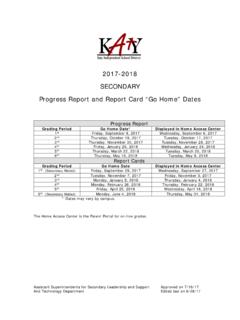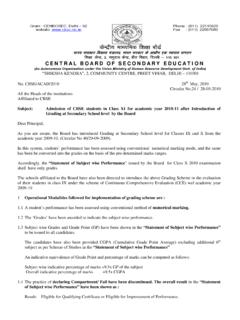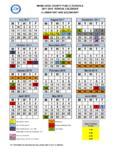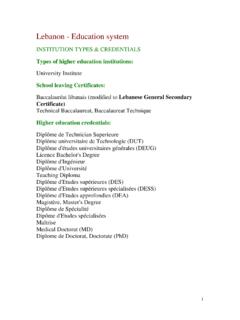Transcription of Secondary Education in Canada: A Student …
1 Secondary Education in canada : A Student transfer guide 9th Edition, 2004 05 Preface Each year thousands of Canadian Secondary school students transfer from one province to another. One of the major concerns associated with such transfers is the continuity of the students ' Education ; that is, will it be possible to enter studies in the new school without gaps or duplications ? Will it be possible to complete school in the same number of years as if the transfer had not taken place ? This document has been prepared to assist receiving schools in placing Secondary students so that their Education can be as continuous as possible. The information for each jurisdiction is divided into two parts: Summary statement Part 1 provides information on Secondary Education in each of the ten provinces and three territories. Principals receiving students from another province or territory will find it valuable to refer to this section for the meaning of specific terms, systems of course numbering, credit requirements, examinations and grading practices, pattern of school organization, curriculum organization, and requirements for graduation.
2 The information for each jurisdiction is presented under the following eight headings: 1. Introduction 2. Organization of School System 3. Explanation of Terms Used 4. Course Designation 5. Time Allotments and Course Load 6. Curriculum Organization 7. Testing and Grading Practices 8. Requirements for Graduation Summary of course content Part 2 contains course descriptions to facilitate the placement of students . An outline is provided of required and elective courses in core academic subject areas for the 2004-2005 academic year. The name of each course is followed by the abbreviation and the course code that appear on the Student 's transcript. Some jurisdictions have included courses that are in the process of being phased in over time. In section 17, most jurisdictions have also identified courses in addition to the core subject areas. Courses described in the document (for example, mathematics in section 13) do not always have the same yearly or course divisions, nor the same sequence of topics, even if the total content may be very similar by the time school has been completed.
3 The person placing the Student will have to assess whether the Student will be better served by a placement involving some gaps in the content, or by one that will result in some duplication. The information for each jurisdiction is generally organized under the following headings; language course headings under sections 9 to 12 may vary slightly for certain jurisdictions: 9. English (First Language) 10. French (First Language) 11. French (Second Language) 12. French (Immersion) 13. Mathematics 14. Science 15. Social Studies 16. List of Prerequisites and/or Co-requisites 17. Other Types of Programs/Courses 18. Assessment of Out-of-Province and Foreign Studies 19. Contact Persons Official documents, such as the Student transcript, often remain the best guide for placing a Student . Secondary Education in canada - A Student transfer guide is not designed to replace official ministry of Education or school handbooks (see Provincial/Territorial Curriculum Guides).
4 It is offered as an aid when the above-noted documents are not readily available for reference. Secondary Education in canada : AStudent transfer Guide9th Edition, 2004 05 AlbertaXML to PDFby RenderX XEP XSL-FO Formatter, visit us at of ContentsSummary 31. 32. Organization of School 33. Explanation of Terms 34. Course 45. Time Allotments and Course 56. Curriculum 67. Testing and Grading 78. Requirements for 8 Summary of Course Content .. 119. English Language 1110. Fran ais (First Language) .. 1111. French (Second Language) .. 1212. French (Immersion).. 1313. 1414. 1515. Social 1916. Prerequisites and/or 1917. Other Types of 2018. Assessment of Out-of-Province and Foreign Studies .. 2019. Contact 2122004 05 AlbertaStudent transfer GuideXML to PDFby RenderX XEP XSL-FO Formatter, visit us at Statement1. IntroductionIn Alberta, the Minister of Education prescribes the outcomes that students should achieve in each subject throughdocuments called programs of study.
5 Programs of study are prepared in consultation with teachers, school principals, students , parents, people from business, other community members, superintendents, school trustees, educationalassociations, postsecondary institutions, and other government departments. Alberta also works with other provincesand territories to develop common learning outcomes for students . School boards and their staffs determine theteaching strategies and materials that will be used to help their students achieve the outcomes in the provincialprograms of study. They may select from the provincial list of authorized resources or choose other resources tomeet the needs of their Organization of School SystemParents and students have a wide range of options to choose from within the public Education system: publicschools, separate schools, francophone schools, charter schools, alternative programs and virtual programs offeredby school boards, and home school year usually extends from September 1 to June 30 of the following year, with variations from systemto system.
6 Some schools provide year-round schooling and other alternative timetables, while others may starttheir school year in August rather than number of instructional days may vary from 190 to 200 days. Generally, a minimum of 190 days of instructionis required. Other days are used by teachers and school administrators for planning, in-service Education , and otherrelated activities. Junior high school students must have access to a minimum of 950 hours of instruction per yearper grade. Senior high school students must have access to a minimum of 1,000 hours of instruction per junior high schools, the majority of courses are offered for the full school year. However, complementary oroptional courses may be rotated on a scheduled basis throughout the year. In senior high schools, courses may beoffered for the full school year or on a semester basis (two per year). Some schools offer Copernican schedulingthat is essentially a quarter-system credit at the senior high school level represents course-specific knowledge, skills, and attitudes.
7 One credit isdefined as being equal to 25 hours of instruction, within which most students can achieve a credit. However, italso is recognized that some students can acquire the knowledge, skills, and attitudes specified for 1 credit in acourse of studies in less than 25 hours, while others may require more methods of school organization are adopted, students must have access to instruction that is focused onthe outcomes of the courses they have chosen and be evaluated on that Explanation of Terms UsedCore coursesCourses that all students are required to coursesCourses that students choose either to help them develop their unique talents, interests, and abilities or to preparefor further studies or entry into the 05 AlbertaStudent transfer GuideXML to PDFby RenderX XEP XSL-FO Formatter, visit us at Course DesignationJunior high schoolStudents register in grades. Courses are named and assigned a number corresponding to the grade in which thecourse is normally offered.
8 For example, English Language Arts 7 is the Grade 7 English high schoolStudents register in courses. Senior high course numbers usually designate the grade level and level of academicchallenge. The numbers 10 to 19 designate grade 10 courses, the numbers 20 to 29 designate grade 11 courses,and the grade 12 courses are designated by the numbers 30 to has several numbering systems, each referring to academic challenge and students postsecondarygoals. In general, the numbering system is as planning entry into university and some programs in colleges and technical schools would enrol incourses with the following numbering systems English Language Arts 10-1, 20-1, 30-1 Fran ais 10, 20, 30 French Language Arts 10, 20, 30 Pure Mathematics 10, 20, 30 Science 10 followed by Biology 20, 30/ Chemistry 20, 30/ Physics 20, 30 Social Studies 10, 20, planning entry into some programs in colleges and technical schools, or some of the trades, or intothe workplace would enrol in courses with the following numbering systems English Language Arts 10-2, 20-2, 30-2 Fran ais 10-2, 20-2, 30-2 French Language Arts 10-2, 20-2, 30-2 Applied Mathematics 10, 20, 30 Science 10, 20, 30 Social Studies 13, 23, 14, 24 and Science 14, 24 are for students planning entry into some of the trades or into designated 15, 25.
9 35 are locally course numbers 16, 26, 36 are reserved for the Integrated Occupational Program, which gives studentsentry-level workplace skills and allows them the opportunity to obtain a Certificate of Achievement instead ofa high school in Career and Technology Studies (CTS) are not numbered in the same 2-digit manner as other CTS curriculum is organized into 22 strands with over 600 courses, each worth 1 credit. The courses areorganized into 3 levels: introductory, intermediate, and 05 AlbertaStudent transfer GuideXML to PDFby RenderX XEP XSL-FO Formatter, visit us at Time Allotments and Course LoadJunior high schoolA course in junior high school represents specific knowledge, skills, and attitudes that most students acquirein the amount of time recommended by the province. It is recognized that some students acquire the knowledge,skills, and attitudes specified in a program of studies in less than the recommended time, and that others requiremore recommended time allotment (hours per year) for each part of the junior high school program is indicatedin the table hours or more per yearEnglish Language Arts250 hours or more per yearFrench Language Arts and EnglishLanguage Arts ORFran ais and English Language Arts100 hours or more per yearMathematics100 hours or more per yearScience100 hours or more per yearSocial Studies75 hours or more per in September 2005, it is planned that students in grades 1through 9 will receive 30 minutes of daily physical EducationHealth and Life Skills Program of Studies has outcomes for each of grades7, 8 and 9.
10 It is recommended that students have access to 50 hours ormore per and Life Skills150 hours or more per yearOptional coursesLocal discretionRemainder of timeSchools shall offer two provincially authorized optional courses except where instruction in a language otherthan English is offered, then only one provincially authorized optional course is high optional coursesSchools are required to offer optional courses since they reinforce outcomes in language arts, mathematics,science, and social studies; as well, they address knowledge, skills, and attitudes that are not encountered inthese subjects. students should be encouraged to continue in grade 8 and grade 9 with at least one of the optionalcourses selected in grade 7. The optional courses are categorized as follows: Career and Technology Studies: Introductory level courses for all CTS strands are consideredappropriate for junior high school students Environmental and Outdoor Education Ethics: This course may be offered in grades 7, 8, or 9 Fine and Performing Arts.











